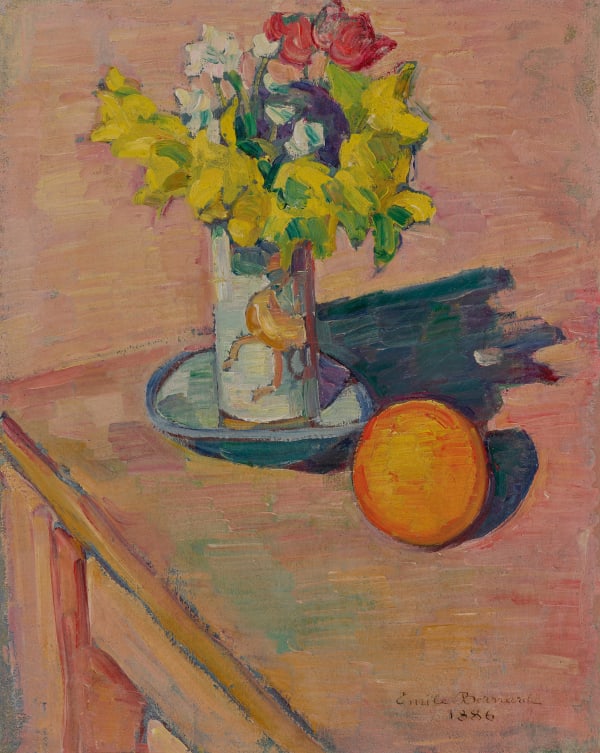Emile Bernard French, 1868-1941
Emile Henri Bernard was a French artist, who remains deeply associated with the development of the Synthetist and Cloisonnist movements and the evolution of art in the late nineteenth and early twentieth century.
Also a poet and an essayist, he extensively contributed to the exploration of new theories in arts. The publication of his correspondences with Vincent Van Gogh, and later Paul Cezanne, helped to consolidate our knowledge and understanding of modern art.
Born in Lille, and raised by his grandmother who encouraged his love of art. Bernard then moved, with his family, to Paris in 1878 and joined the Atelier Cormon. Here, he met the fellow artists, Louis Anquetin and Henri de Toulouse Lautrec.
In 1886, Bernard, then only eighteen years old, began a trip to Brittany where he later settled in Pont-Aven and would meet with Paul Gauguin for the first time. It was in Pont-Aven that Bernard continued his lessons in Plein-Air painting, which allowed him to keep close proximity to Neo-Impressionists and slowly experiment with new techniques.
The years 1887 and 1888 were crucial in marking Bernard’s transition from Neo-Impressionism to the developing Synthetism, where he engaged a more symbolist vision of Nature. Cloisonism, as a style of painting, is defined by the purity of its compositions: the simplification of forms in the schematisation of nature and the use of bold colours, emphasized by simple and clear contours. Sharing his time between Asnieres and another trip to Brittany, Bernard began a close friendship with Vincent Van Gogh, as they exchanged and reflected on painting. Both artists were influenced by Japonism and the Dutch Old Masters. This encouraged a subsequent development of new forms of colour and styles which aroused new sets of feelings.
His various trips to Pont-Aven would lead to an exceptional quality of works heralding the new Synthetistic style, as an essential Modern movement.
In 1891, Bernard’s close association with Paul Gauguin ended, after taking offence to the popular belief/misconception that Gauguin spear-headed the Synthetist movement.
Searching for both a new identity and new aesthetic ideas, Bernard visited the Exposition Universelle in 1889 (Paris), where he became intrigued by the Middle East region. He henceforth decided to move to Egypt in 1893, where he settled for ten years.
From 1892, the artist shifted his practice, and returned to more classical compositions, which engaged with the Renaissance masters, and other forms of Classical aesthetics. In part, this was influenced by a trip to Spain, but fundamentally, Bernard’s growing interest in religious and mystical themes.
Upon his return to France, in 1904, the artist stayed in Aix-en-Provence and spent his time working with Paul Cezanne. Their meeting would lead to a continuous and thorough artistic correspondence, which lasted until the Cezanne's passing away.
Bernard remains a pivotal figure in the development of modern aesthetic theories; his practice and writing aided important artistic innovation on colour and composition.
The artist’s works can be found in numerous global museums: the Musee d’Orsay, Paris; Chicago Art Institute, Chicago; Metropolitan Museum of Art, New York ; Museum of Modern Art, New York ; Thyssen Bornemisza, Madrid ; Indianapolis Art Museum, Indiana ; Quimper Museum, Quimper.
-

TEFAF Maastricht
13 - 20 Mar 2025We are delighted to participate in TEFAF Maastricht 2025, where we are exhibiting a selection of 19th—and 20th-century French paintings and works on paper. Among the highlights is a curated...Read more -

Salon du Dessin - 2024
20 - 25 Jan 2024Read more -

TEFAF Maastricht 2023
11 - 19 Mar 2023Join us at TEFAF Maastricht 2023, where we are exhibiting a selection of 19th and 20th-century French paintings and works on paper, including works by Eugène Boudin, Gustave Courbet, Charles-François...Read more -

Rhythm of lines and colours in French Avant-Garde
28 Jun - 26 Jul 2019Stoppenbach & Delestre is pleased to present 'Rhythm of lines and colours in French Avant-Garde', an exhibition including works by Charles-François Daubigny, Eugène Boudin, Armand Guillaumin, Hippolyte Petitjean, Louis Valtat,...Read more







